Gas mask
![]()
Gas mask is a redirect to this article. For gas masks as a fetish, see gas mask (BDSM). For the 1923 drama, see Gas masks.
A respiratory protection mask (colloquially gas mask, respiratory mask, in the military and civil defence area CBRN protective mask or ABC protective mask, in the National People's Army troop protection mask) is a protective mask that partially or completely covers the face. It serves the protection of the wearer against airborne pollutants (respiratory poisons) or pathogens. The various devices are divided into full masks (standardised according to EN 136) and half and quarter masks (EN 140). Half masks include particle-filtering FFP masks (filtering face piece). Respiratory protection systems of this type are required where substances hazardous to health must be prevented from entering the respiratory tract; for example, in rescue work, with the fire brigade, with the technical relief organization, in fire investigation and at workplaces where respiratory toxins (chemical substances, dusts) can occur, e.g. during tank cleaning work.
The respirator can be made of rubber, silicone rubber or a plastic. In the past, leather or fabric, sometimes with a rubber coating, were also used. Respirators can be used in conjunction with compressed air breathing systems for self-contained breathing or with breathing filters for self-contained breathing. In the self-contained version, the respiratory filter can either be attached directly to the mask or connected to it via a hose. Several filters or a blower can also be attached for relief. A distinction is made between normal pressure masks and positive pressure masks. In the meantime, a respiratory protection mask with integrated data goggles has also been developed to enable navigation in smoke-filled rooms. The system is based on room localization electronics.
During the COVID 19 pandemic, everyday masks ("mouth-to-nose cover") and medical hygiene masks ("mouth-to-nose protection") are primarily worn by the public. These do not count as respirators because they are designed primarily for third-party protection rather than self-protection of the wearer. An overview of various infection protection masks can be found under protective mask.
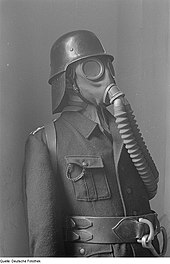
Uniform of the fire brigade with breathing mask, 1948
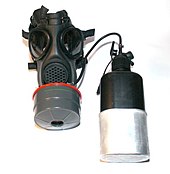
Modern breathing mask of the Swiss Army with attached drinking hose and field bottle
Development
The beak-shaped masks filled with herbs used by medieval plague doctors can be seen as the first precursors of respiratory masks.
Pioneering work in the field of respiratory protection was done by the Frenchman Jean-François Pilâtre de Rozier when he presented the design of the first suction hose respirator with breathing mask in 1785.
Gas masks were introduced by all belligerents during the First World War in the course of the development and use of chemical warfare agents to fight ground troops. The gas mask is intended to protect the respiratory tract and eyes in particular. Respirators and simple breathing masks, which mainly protected the wearer from dust, had already been in use before, especially in mining. The first gas mask with a carbon filter was invented in 1915 by the Russian scientist Nikolai Dmitrievich Selinski. Other inventors in the field were Garrett Morgan and Cluny MacPherson.
Models from the First World War were made of impregnated fabric and often had no filter or were only fitted with a cotton filter. As the war progressed, chemical-absorbing materials were used. In addition, special masks were developed for horses, which still played an important role in warfare at that time.
Before the Second World War, various states developed so-called people's gas masks to protect the civilian population. Since the Second World War, there have also been special gas masks and gas protection hoods for children.

German soldiers with gas masks in the First World War

US soldiers with gas masks, 1917
Structure
Full-face mask
Full-face masks usually consist of a mask body made of silicone or rubber, one or two lenses in a sealing frame, the exhalation valve, partly the carrying strap, the strap (spider), an inner mask or air ducts, a speaking membrane and the connection piece for a regulator (regulator) or breathing filter.
Two separate visors are used mainly in the military sector for easier transport of the mask.
The strapping can also consist of a system that tightens the mask and helmet together (helmet-mask combination), especially for firefighters. In the military sector, flexible rubber headgear is sometimes used instead of the strapping.
Some masks are also fitted with a strap to hang the mask around the neck; especially in aviation, a plastic or metal hanger may also be fitted to hang the mask.
An inner mask is used to reduce functional dead space. Breathing air is brought into the mask body via control valves and passes over the lens, thus preventing fogging. If an inner mask is not used, air ducts are provided instead, which allow the air to flow along the lenses.
To prevent fogging, so-called clear discs were used in the past. These were thin celluloid discs that were coated on the inside with a gelatin layer that absorbed moisture. The clear discs were fixed in front of the eye discs by means of a retaining ring (snap ring).
A distinction is made between rigid and semi-rigid (flexible) masks. Extended protection and comfort are provided by hoods, which are used by rescue services and also for certain activities (sandblasting) and are connected to the helmet and full protective suit.
Particle filtering half mask (FFP mask)
A half mask encloses the nose and mouth. The eye area is left out. In contrast to the full face mask, the sealing line runs over the nose area, which is more difficult to seal.
Particle filtering half masks or FFP masks (Filtering Face Piece; fine dust mask, dust mask or respiratory protection filter) protect against the inhalation of particles and aqueous or oily aerosols, depending on the design. They are usually made entirely of non-woven fabric with rubber straps and a mouldable nose clip to optimise the fit to the face.
Standardized masks with CE marking can protect against respirable dusts and liquid mists within their respective area of application when used properly. In addition to the supporting filter material, they have layers of an electrostatic material (electret, see also electret filter). Here, small dust particles, liquid droplets and aerosols are bound by four physical mechanisms (sieve effect, inertia effect, diffusion, electrostatics). However, the electrostatic effect decreases after some time due to dust accumulation and moisture penetration. The deposits also lead to a noticeable increase in breathing resistance.
How the mask fleece works and how it is made are clearly described in this article by Deutsche Welle.
Areas of application are, for example, dust protection masks for grinding work in the trades or on construction sites, for silo inspections, in mining or against aerosols, e.g. when applying water-soluble paints with a spray gun or airbrush; particle-filtering half masks designated as infection protection masks can provide at least partial protection against various aerogenically transmissible pathogens, such as SARS-CoV-2. Particle-filtering half masks usually consist entirely of the filter material.
They do not provide protection against gases and vapours, even if they are provided with an insert of activated carbon. This insert serves to protect against unpleasant but harmless organic odours (e.g. for handling slaughterhouse waste, in animal husbandry or waste disposal). Protection against gases can only be achieved with special gas filters.
Classification in Europe
A classification is made according to the European standard EN 149 in three particle filter classes. The total leakage of a mask is used for assessment, which is composed of leakage points on the face, leakage on the exhalation valve (if present) and the actual filter passage.
| Class | Total leakage | Protection against particle sizes (max. 0.6 μm) and range of application |
| FFP-1 | Not more than 25 %, mean values not greater than 22 | for non-toxic and non-fibrogenic dusts; maximum concentration up to 4 times the maximum workplace concentration |
| FFP-2 | Not more than 11 %, mean values not greater than 8 | Protection efficiency at least 95 %; for harmful dusts, mists and fumes; filters for solid and liquid particles; against harmful substances whose concentration is up to 10 times the maximum workplace concentration. |
| FFP-3 | Not more than 5 %, mean values not greater than 2 | at least 99 %; protection against toxic substances as well as droplet aerosols, carcinogenic or radioactive substances, enzymes, micro-organisms (viruses, bacteria, fungi and their spores); against harmful substances in concentrations up to 30 times the maximum workplace concentration. |
Furthermore, the following additions are possible:
| Additional designation | Meaning |
| S (solid) | solid aerosols and particles |
| SL | aqueous and oily aerosols and particles |
| V | with exhalation valve to reduce breathing resistance |
The additional designations S and SL were dropped with EN 149 of 2001 (EN 149:2001). Products tested according to this standard protect against both fine dusts (S) and liquid aerosols (SL), so that a distinction between S and SL is no longer necessary.
According to EN 149:2001+A1:2009, additional letters are added to the designation FFP X (X: 1, 2, or 3):
- D: Successful dolomite dust exposure test: The test consists of exposing the particulate filtering half mask to a sinusoidal breathing simulation while the sample is surrounded by a known concentration of dolomite dust in air. Subsequent to the exposure, the breathing resistance and filter passage of the particulate-filtering half-mask sample are measured. The packaging of those particle-filtering half masks which have passed the single-storage test with dolomite must also be marked with the letter 'D'. This letter follows the class marking after a single space.
- R and NR (reusable and not reusable): If the manufacturer also fulfils the additional condition that disinfection of the FFP mask is possible and described, he can mark it with "R" for reusable. An "NR", on the other hand, means that the use is limited to the duration of one shift.
Simple versions without a standard test mark (the former designation coarse dust mask is no longer permissible; instead, these are now often found on the market under the designation mouthguard or hygiene mask) only protect against liquid droplets and coarse dusts due to their pore size, which do not penetrate into the lungs anyway. At best, they offer protection against droplet infection in the case of colds or other diseases that can be transmitted in this way. In the case of dust accumulation, they only protect against grinding on the teeth; they do not protect against the health consequences of dust exposure, but rather increase the danger due to the collecting effect.
Labelling of marketable masks from USA, Canada, Australia, New Zealand and Japan
In the United States, the National Institute for Occupational Safety and Health (NIOSH) has issued 42 CFR Part 84, which divides NIOSH-approved particulate filtering facepiece respirators into seven classifications (N95, Surgical N95, N99, N100, R95, P95, P99, and P100) (United States NIOSH-42CFR84). The letter N indicates that the mask marked with it is not oil resistant, while an R indicates partial oil resistance and a P indicates strong oil resistance. The numbers represent the respective filtering performance of aerogenically transmissible particles; e.g. masks with the code 95 filter at least 95 %; for masks with the code 100, at least 99.97 % filtering performance must be demonstrated.
→ Main article: N95 mask
The masks that comply with this standard must also bear other markings, e.g. the logo or name of the NIOSH and the model number. According to the Federal Institute for Occupational Safety and Health (BAuA), the mask of the "N95" standard "essentially meets the requirements for FFP2 masks".
In Canada, the NIOSH-certified masks are also used. In addition, the Canadian Standards Association (CSA) standard Z94.4-11 Selection, Use and Care of Respirators has been published there.
In Australia and New Zealand, the standards organizations Standards Australia and Standards New Zealand issued a joint standard, AS/NZS 1716-2012 Respiratory protective devices. Corresponding masks or their packaging must be marked with AS/NZS 1716. Standard P2 masks "substantially conform to the requirements for FFP2 masks".
In Japan, according to JMHLW Notification 214 (2018), the DS designation is considered one of several standards for dust masks, with the DS2 standard "substantially equivalent to the N95 standard in the United States." Before placing on the market, manufacturers or importers must pass the Japanese national type approval for the respective products.
defective products database
Information on defective products can be found on the website of the Federal Institute for Occupational Safety and Health. The Federal Institute for Occupational Safety and Health (Bundesanstalt für Arbeitsschutz und Arbeitsmedizin, BAuA) publishes product recalls, product warnings, prohibition orders and other information on dangerous individual products that are regulated in Germany by the Product Safety Act (Produktsicherheitsgesetz, ProdSG), among other things, in its "Dangerous Products" database.
Database for FFP masks approved in the EU
FFP masks without or with incorrect CE marking are also placed on the market. The NANDO database of the EU Commission provides information on whether the CE certification body printed on an FFP mask (e.g. CE 0044, TÜV NORD) is approved for the marketing of respiratory protection masks in the EU.
Application of FFP masks
FFP masks are used as part of personal protective equipment as part of occupational safety in areas where harmful substances are present in the air. Masks without a valve filter both the inhaled air and the exhaled air and are therefore suitable for personal and external protection. A mask with an exhalation valve, on the other hand, only filters the inhaled air and is therefore only suitable for self-protection. Masks with an exhalation valve are therefore not suitable for compulsory mask use in public places, as they do not provide any external protection; unless the valve is covered with a fleece in accordance with DIN EN 14683, e.g. an additional mouth/nose protector. On the other hand, the reduced heat and moisture accumulation increases the wearing time, which should be taken into account in case of limited availability. Another problem is that many masks currently on the market and labelled as FFP2, some of which have been used in hospitals, do not meet the protection criteria.
Especially in intensive care units, FFP2 and FFP3 masks are used to protect employees against infection. The Technical Rules for Biological Agents applicable in Germany require that at least FFP2 masks be worn when working on or in the immediate vicinity of patients who have contracted airborne pathogens. This applies, for example, when providing direct care to patients with confirmed or probable coronavirus disease-2019. When FFP2 masks are not available, an oral-nasal protector should be used to protect against droplets. Respirators (FFP3) should be worn during all activities involving heavy aerosol production (e.g., intubation or bronchoscopy).
Since incorrect donning and doffing of personal protective equipment (PPE) can lead to unwanted contamination, special procedures are indicated in each case, including the handling of protective masks. In connection with the COVID 19 pandemic, the Robert Koch Institute issued recommendations on this subject, including instructions for specialist personnel on the safe donning and doffing of respirators and protective goggles.
General instructions for the correct use of FFP masks
FFP masks are a complex medical device. Therefore, important rules must be observed during use in order to avoid infections due to improper use. The health department of the Mainz-Bingen district administration, for example, has compiled corresponding instructions (see below).
- Approved FFP masks bear the CE mark with the four-digit number of the respective testing agency. Only masks without an exhalation valve should be worn for external protection against viruses.
- To avoid confusion, the own mask should be marked with a color dot, name or similar.
- For reasons of hygiene, the inside of the mask should not be touched.
- Hands should be disinfected before putting on the mask.
- The mask should first be placed on the chin.
- To adjust the nose clip, first press it from above onto the bridge of the nose and then against the two sides of the nose.
- The mask must always completely cover the mouth and nose.
- Care must be taken to ensure that the edges of the mask are tightly fitted.
- When the mask is worn for the first time, the tightness of the mask is checked by blowing it out while pressing it lightly on both sides with the hands. If necessary, the fit of the mask or the adjustment of the nose clip to the contour of the nose is corrected. The correct fit of the mask can also be recognised by the fact that it contracts when you inhale and inflates again when you exhale.
- It should be noted that a beard prevents a tight fit of the mask and allows unfiltered air to pass through. Even a three-day beard can reduce the filtering performance of the mask.
- When putting on and taking off the mask, touch the mask only at the retaining straps if possible. Hands should be disinfected after touching the mask.
- The mask should be stored in the shade and in a dry place, as UV radiation, moisture and humidity impair the protective electrostatic charge of the mask fleece. Unlike fabric masks, filter masks should therefore not be washed or treated with steam, liquid disinfectants or other liquids.
- After wearing the mask, place it inside out on a previously disinfected surface. This prevents potential viruses from reaching the inside of the mask from the storage surface or via droplets and aerosols in the ambient air. Alternatively, the mask can be hung on the wall with the inside facing the wall. The mask should not be placed in a jacket or trouser pocket if money, keys or other potentially contaminated items are also stored inside.
- The mask should be replaced with a new one after 8 hours of wear and immediately in case of damage.
Certain FFP masks are attached to the neck and the back of the head. These therefore have to be put on and taken off differently than FFP masks with ear straps, as demonstrated in an instructional video by the mask manufacturer Dräger. It should be critically noted that the mask should not be slipped off to the back over the hair, as in the film, but to the front, as a contact infection via the hair cannot be ruled out according to the Employer's Liability Insurance Association for Health Services and Welfare Care.
Wearing time under mangle conditions
Unless otherwise specified by the manufacturer, for hygienic reasons FFP masks are generally intended for single use within a working shift of a maximum of eight hours. In the case of reusable masks, the sealing rim of the mask must be disinfected if provided for by the manufacturer. In Germany, the occupational health and safety committees at the Federal Ministry of Labour and Social Affairs (BMAS) recommend wearing a protective mask with a breathing valve for a maximum of 120 minutes, and without a breathing valve for a maximum of 75 minutes; a recovery period of 30 minutes must be observed before re-use.
Depending on the activity, an occupational medical examination of the employee may be required if he wears FFP masks for more than 30 minutes per day in the course of his work. The German Social Accident Insurance (DGUV) recommends in its instructions for occupational health screening in accordance with DGUV Principle G26 Respirators (BGI/GUV-I 504-526) that the company doctor be involved and that a risk assessment be carried out in accordance with the Occupational Health and Safety Act.
Several studies conducted in 2006 looked at the health effects of prolonged use of N95 masks: One found that wearing the masks for more than four hours resulted in increased headaches (because the mask on the face interferes with the removal of carbon dioxide during exhalation). Skin reactions, some of them inflammatory, were noted in another study in which the N95 masks were worn for an average of eight hours a day over a period of more than eight months.
Reusability of FFP masks
Reusable masks of type FFP 2 or 3 are marked with the letter "R" for reusable and are CE certified; they comply with EN standard 149. Test documents, handling instructions and disinfection must be provided by the manufacturer.
In some clinics, to address a shortage, FFP3 masks that were mechanically sound were also reprocessed, sterilized, and reused. However, they were sometimes subsequently downgraded by one level from FFP3 to FFP2 for safety reasons. For certain reprocessing procedures of comparable disposable N95 masks, a Centers for Disease Control and Prevention (CDC) working group was able to show a reduction in filtering efficiency of up to 40%, while other procedures largely preserved filtering efficiency. Based on existing research on the reprocessing of N95 protective masks, recommendations for the U.S. healthcare system to implement limited reprocessing were published by the CDC. In the context of the COVID-19 pandemic, an interdisciplinary research consortium was formed with N95DECON, which is scientifically concerned with the decontamination and reusability of the masks and regularly publishes the resulting findings.
Exemptions 2020 for Germany in the COVID 19 pandemic
The Robert Koch Institute (RKI) issued an action option in March 2020 to address the increasing shortage of oral nasal protection (MNS) and FFP2 masks in the context of the COVID 19 pandemic. This governed the resource-efficient use of mouth-nose protection (MNS) and FFP masks in healthcare facilities during supply shortages. The recommendation was prepared in consultation with the ad hoc working group on SARS-CoV-2 of the Committee on Biological Agents (ABAS) and in cooperation with the Federal Ministry of Labour and Social Affairs, and included advice on possible reprocessing or disinfection procedures. According to the submission of the BMAS and the Federal Ministry of Health (BMG) for the crisis team of the Federal Government of 31 March 2020, the exemptions for reuse were limited to a maximum of six months. The document thus lost its validity on 31 August 2020, again excluding the possibility of reusing MNS and FFP masks in "declared emergency situations" under certain conditions for the health sector. On 11 January 2021, a team of experts from Münster University of Applied Sciences and WWU Münster published guidance on the reuse of FFP2 masks for private use. It recommends rotating 7 masks in a week so that each mask has 7 days to dry. This cycle should only be repeated five times. To reduce any contamination, the mask can be placed in a boil bag or freezer bag in a closed saucepan of boiling water for ten minutes, with the bag not touching the bottom of the saucepan. The mask should be disinfected in this way a maximum of three times. Alternatively, it is recommended to dry masks in the oven for 60 minutes at 80 °C top/bottom heat. With this procedure, masks should only be reprocessed five times and then discarded.
Accelerated testing due to COVID-19
In response to Recommendation (EU) 2020/403 of the European Commission in mid-March 2020, the Institute for Occupational Safety and Health of the German Social Accident Insurance (IFA) and DEKRA Testing and Certification GmbH developed a rapid test for respiratory protection masks: this was intended to limit the acute shortage of European-approved products with so-called pandemic respiratory protection in the short term. In this way, the authorities of the EU member states were able to purchase respirators without CE marking in an organized manner and make them available for a limited period of time. The condition was that the respirators should ensure an adequate level of health and safety. In addition, in the event of an acute shortage, the masks were to be available only to medical and nursing professionals for the duration of the health threat posed by the COVID-19 pandemic. Respirators that had passed testing under this test principle were certified as having a technical presumption of conformity with a validity of twelve months. It is possible to market the product as regular respiratory protection in the area of the European Union if it passes a full test according to EN 149 and a conformity assessment according to the Personal Protective Equipment Regulation (EU) 2016/425 has been carried out by a Notified Body.
As of October 1, 2020, market surveillance authorities will no longer issue confirmations of marketability. Corona Pandemic Respirators (CPAs) that were placed on the market before October 1, 2020, in accordance with Section 9 may continue to be distributed and selected and provided by the employer after September 30, 2020.

Makeshift sterilization in the oven (2020)

N95 mask
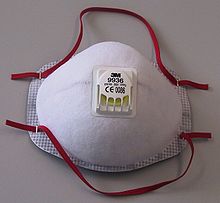
FFP-3 respirator with exhalation valve
.jpg)
FFP-2 respirator without exhalation valve
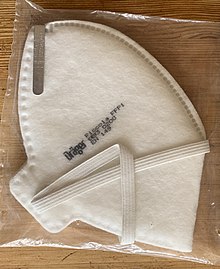
FFP-1 respirator
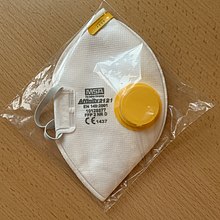
FFP-2 respirator with exhalation valve
Search within the encyclopedia